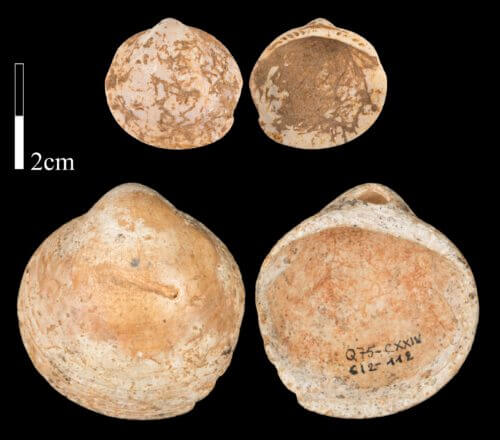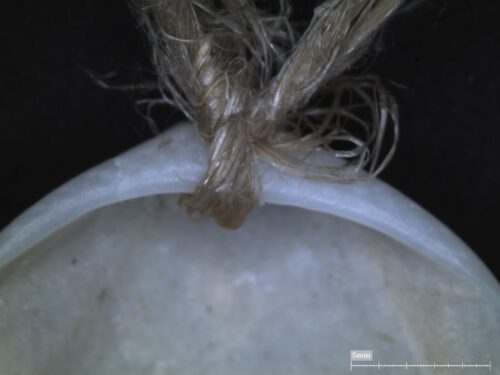In a study conducted by the Steinhardt Museum of Nature at Tel Aviv University together with the Institute of Archeology at Haifa University, it was discovered that not only were the first human beings decorated with shells, but that between 160 and 120 thousand years before our time, the thread on which the beads were tied was invented. This is also why the oysters from that period found in a human habitat were perforated. The main researcher, Dr. Daniela Bar-Yosef: It is most likely linen threads

A new study led by Dr. Daniela Bar-Yosef from the Steinhardt Museum of Natural History at Tel Aviv University, together with Dr. Iris Groman-Yaroslavsky from the Research Laboratory for Signs of Use at the Zinman Institute of Archeology, Haifa University, reveals that the Naami shells, The "seashells" machines, the most common on the seashores in Israel, were used by the first modern man as decorative objects already over 100,000 years ago. The research partners come from the universities of Haifa, Tel Aviv, Jerusalem, Harvard in the USA and Bordeaux in France, on whose behalf the excavation managers are.
The study's conclusions are based on two main findings: in the Mycelia Cave in the Mount Carmel National Park, where the remains of a modern man who came from Africa over 160,000 years ago were discovered, a group of shells that were not perforated was discovered. Some could have been used as food (and eating shellfish, which is known from other sites in the Mediterranean basin) and others were probably collected for their symbolic value. Various studies show that man has an attraction to round and convex shapes and it is possible that collecting the Naomi shell was related to the world of beliefs of the ancients. It is interesting to note that also at a site in South Africa that were about 160,000 years old, unperforated Neamites were discovered.
On the other hand, Naomis discovered in the Kapza Cave in the Lower Galilee, where modern human remains were also discovered and whose age ranges from 120,000 to 90,000 years before our time, were all characterized by a hole in their tops and it was found that they were threaded on a thread. These join additional testimonies from other sites of the same age in Israel and North Africa where perforated shells were used.
In a conversation with the Hidan website, Dr. Bar-Yosef says that this is probably one of the oldest evidences of the use of threads. There is evidence from 70 thousand years ago from two sites in France. Neanderthals lived in these sites, but it is not known if they invented the wires. Homo sapiens probably brought the threads to the Neanderthals. We know that there was interaction between the two species and we all even carried Neanderthal genes.
There is further evidence of shell strings from 115-120 thousand years ago from North Africa, where the Neanderthals never reached. The very fact that 120 years ago there are suddenly perforated shells seems no coincidence." The threads themselves did not survive. Ten shells were found in the cave, seven of them more or less intact. We chose the five that are in the best state of preservation to check them for signs of wire use."

In order to confirm the hypothesis that the shells were indeed threaded, Dr. Iris Gruman-Yaroslavsky from the Laboratory for the Study of Marks of Use at the Zinman Institute of Archeology, Haifa University, conducted a series of experiments to examine the microscopic marks that form on shells after humans use them: in the experiment, shells were worn Modernity against different natural materials: wood, leather, clay, rubber, different types of stones and ocher (red earth color). Threads were also made from linen fibers and threaded through naturally perforated shells (such as can be found on the seashore). The threads were threaded through the shells, tied in different patterns and shaken, in order to simulate prolonged wear. Examining the shells from the experiment and comparing the findings to the shells from Kapza Cave showed that the ancient shells, about 120,000 years old, bore tiny grooves of a certain sample in the hole area which were the result of grinding on a wire. Also, tiny grooves from another sample were found on most of the shells, the result of applying ocher on top of the shell, as well as signs indicating that the shells had rubbed against each other. Hence, once the technology for producing threads from plant fibers was invented, it could be used to decorate with strings made of shells.
Dr. Daniela Bar-Yosef, Steinhardt Museum of Natural History: "We hypothesize that the decoration was not only intended to express the beliefs that man attributed to the shell, but perhaps also to express identity or tribal or class affiliation in front of other human populations. The timing of the invention of threads is significant beyond the desire or ability to decorate. Thread-based technology enabled a number of other significant developments related to human evolution, including the creation of hunting traps and fishing nets, the creation of the bow for hunting with an arrow, fishing with hooks and diverse uses related to sailing at sea - for example, tying logs to create a raft, and even various uses related to clothing. At this point we do not have direct evidence of these technologies in this early period, but microscopic evidence of the existence of fibers from plants is increasing in recent years."
Can you tell us what is known about the jewelry at that time?
"Shells are decorative objects and are found on many sites. When talking about jewelry, it creates the illusion of something modern, but the oldest decorative items that exist are shells and their use is increasing and in the very ancient periods - the Middle Paleolithic period (the period in which the research is concerned) the inhabitants of the cave chose a limited number of species of shells out of thousands of species that exist in nature. This strengthens the argument that they had a symbolic use.
How does this go with the fact that the cave is far from the beach?
Bar-Yosef: "It is assumed that they arrived on foot. The cave is about 30-40 kilometers as the crow flies. Such a distance can be covered on foot comfortably in two days and also hunt animals on the way. Also in other sites in Africa that we find in these periods Ben shells are up to 100 kilometers from the seashore.
"These are small hunters. They lived in nature, relied on nature for their sustenance. They had to know where to find the animals they wanted to hunt, as well as fruits, seeds, roots and tubers of plants. They knew both reservoirs of fresh water and the sea, they probably used salt, and eventually to create mats and tangles. "

If you did not find the thread, why do you think it is linen?
The flax plant grows wild throughout the country. My husband, Prof. Ofer Bar-Yosef, who passed away recently, discovered in the 9,500s a selection of linen products in a Neolithic cave from about XNUMX years ago in the Judean Desert - the oldest find of its kind. Apparently the use of this plant was also common before but was not used to produce complex products.
Ofer Bar-Yosef, who excavated in the Kapza cave and was involved in this research in its early stages, died a few months ago before the publication of the article.
What can you tell about dirt?
My husband passed away three and a half months ago at the age of 82. He was one of the two directors of the excavations in the Kapza Cave, he knew my idea about this find and supported the research in this respect as well, following closely and donating his research funds for the benefit of this effort. Ofer was a professor for 45 years. About twenty years at the Hebrew University and then 25 years at Harvard University. Ofer was a well-known and influential figure in the field of prehistoric archaeology. He put many generations of historians in the country. Today, about 90% of the people involved in prehistoric archeology are his students or students of his students. Even in the USA he trained many students and collaborated with many researchers from all over the world."
About Ofer Bar-Yosef in Wikipedia.
More of the topic in Hayadan:
- Did Neanderthal man and Homo sapiens unite in Israel?
- Cave dwellers? Not necessarily
- A study of skeletons in Syria and a comparative genetic study of populations reveals: the Neolithic brought agriculture and culture from the Fertile Crescent to Europe by sea
- Archaeologists have discovered a prehistoric settlement that connects the Early and New Stone Age

3 תגובות
Ha!
Maybe they braided the threads in their hair?
Father, it is written very nicely and I am definitely happy with the result.
I would appreciate it if you could please correct it in relation to the dirt: he has put up many generations of archaeologists or prehistorians (not the historians).
And regarding: "Today about 90% of the people who are engaged in prehistoric archeology are his students or students of his students" - it is important to note that in Israel or to associate with the previous sentence. Because the way it is, it sounds like it's in the world and that's definitely an exaggeration...
But again most thanks!
Danielle